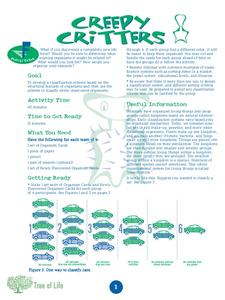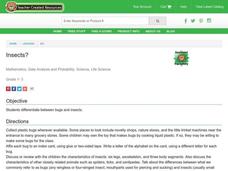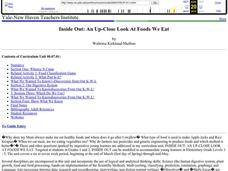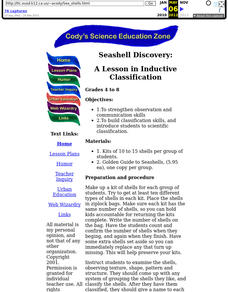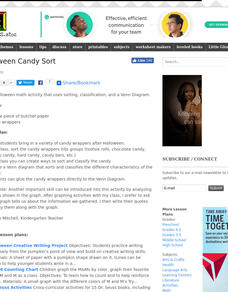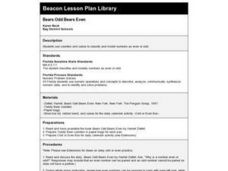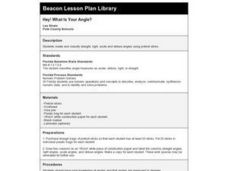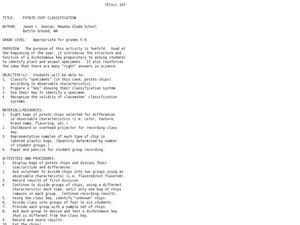Curated OER
School Yard Park/ Ecosystem
Fifth graders examine ecosystems in their schoolyard. In this nature and ecosystem instructional activity, 5th graders map their schoolyard into workable plots. They classify plants and animals found in the plot. They revisit their site...
Curated OER
Plant classification
For this plant classification worksheet, students classify plants into flowering and non flowering plants. Students classify 14 different kinds of plants.
Curated OER
Fascinating Creatures
Sixth graders explore the characteristics of mythological creatures. In this mythology lesson, 6th graders use print and Internet sources to define and classify mythological creatures, such as Centaur, Cerberus, Chimera, Cyclops,...
Curated OER
Cones, Cylinders, Spheres
Students classify polygons by name and shape. For this geometry lesson, students identify the lateral surface of each conic. They differentiate between cones, cylinders and spheres.
Curated OER
Creepy Critters
Learners classify imaginary newly discovered organisms. In this classification activity, students are given cards showing imaginary organisms that have been recently discovered. They must classify the organisms based on their...
Curated OER
Invertebrate Classification Challenge
Sixth graders practice invertebrate classification using the organisms that are discussed in their textbooks. In this classification lesson students work in teams to classify organisms.
Curated OER
Insects?
Students classify animals. In this insects and bugs lesson, students discuss the characteristics of insects and other closely related animals such as spiders, ticks and centipedes. Students talk about the differences between insects and...
Curated OER
Polynomial Functions
Students explore polynomial functions. For this Algebra II lesson, students explore graphs of polynomial functions as classify the functions as linear, quadratic, cubic, or quartic. Students determine the regression equation...
Curated OER
Rock Collecting
Students practice classifying rocks in the categories sedimentary, igneous, and metamorphic. They bring personal rock collections to school, then correctly label the three types of rocks on posterboard.
Curated OER
Inside Out: An Up-Close Look At Foods We Eat
Fourth graders identify the origins of meats and vegetables consumed by humans on a daily basis. They classify foods (meats, dairy products, grains...) and create a food pyramid.
Curated OER
Squares to Compare
Students investigate how to draw and classify two and three dimensional figures (squares, triangles, rectangles.)
Curated OER
Similar and Congruent Triangles
Students create and classify different types of triangles using an online geo-board. They explore the concepts of similar and congruent as they discover how to draw similar and congruent triangles.
Curated OER
Investigating the Food Pyramid
Students examine how the food pyramid is an important nutritional tool. They classify foods and compare the number of servings per group that are necessary for maintaining good health by placing empty food containers in grocery bags.
Curated OER
Seashell Discovery: A Lesson in Inductive Classification
Young scholars examine the shells, observing texture, shape, pattern and structure. They should come up with any system of grouping the shells they like, and classify the shells.
Curated OER
Halloween Candy Sort
Students use their Halloween candy to practice sorting and classifying. They compete a Venn diagram comparing their candy wrappers. They develop ways as a class to catorgize the candy in different ways.
Curated OER
It's Alive
First graders critically analyze living and nonliving objects, then develop a list of characteristics to classify objects on a science walk. They make a book to close out the lesson.
Curated OER
Bears Odd Bears Even
Learners listen to a read aloud of Harriet Ziefert's Bears Odd Bears Even. They count cubes and counters to classify and show numbers as odd or even.
Curated OER
Hey! What Is Your Angle?
Fifth graders create and classify straight, right, acute and obtuse angles. In this clever lesson, 5th graders utilize pretzel sticks to form different types of angles. Best of all, they get to eat them at the end!
Curated OER
Potato Chip Classification
Students classify specimens by observable characteristics. By classifying potato chips, they are introduced to the dichotomous key for identifying plant and animal specimens.
Curated OER
Classification is Sweet
Students classify, weight and organize items during this instructional activity. This instructional activity works great as or with an introduction of the Periodic Table of Elements.
Curated OER
Everybody Needs a Rock
Students, after making quantitative and qualitative observations of their rocks, construct a Venn diagram or dichotomous key to classify their rocks.
Curated OER
Preparing for a Job Interview
Students explore the process of preparing for a job interview from the classified search to the actual interview. Lists of potential questions to be asked and answered are prepared and shared with the class.
Curated OER
Familiarizing Students with the 5 Food Groups
Students review a variety of foods and classify them into food groups. They identify the benefits of each food group to our bodies and consider how deficiencies of these groups affect humans. They sort pictures, view a video and write...
Curated OER
See Our Collection
First graders classify plants and animals based on their characteristics using examples from the westward journey of Lewis and Clark and the Corps of Discovery.
Other popular searches
- Classifying Triangles
- Classifying Quadrilaterals
- Classifying Polygons
- Classifying Organisms
- Classifying Rocks
- Classify and Categorize
- Classify and Categorizing
- Classify Living Things
- Classifying Angles
- Classify Triangles
- Classify 3d Shapes
- Classifying Objects




